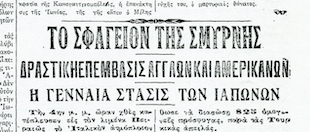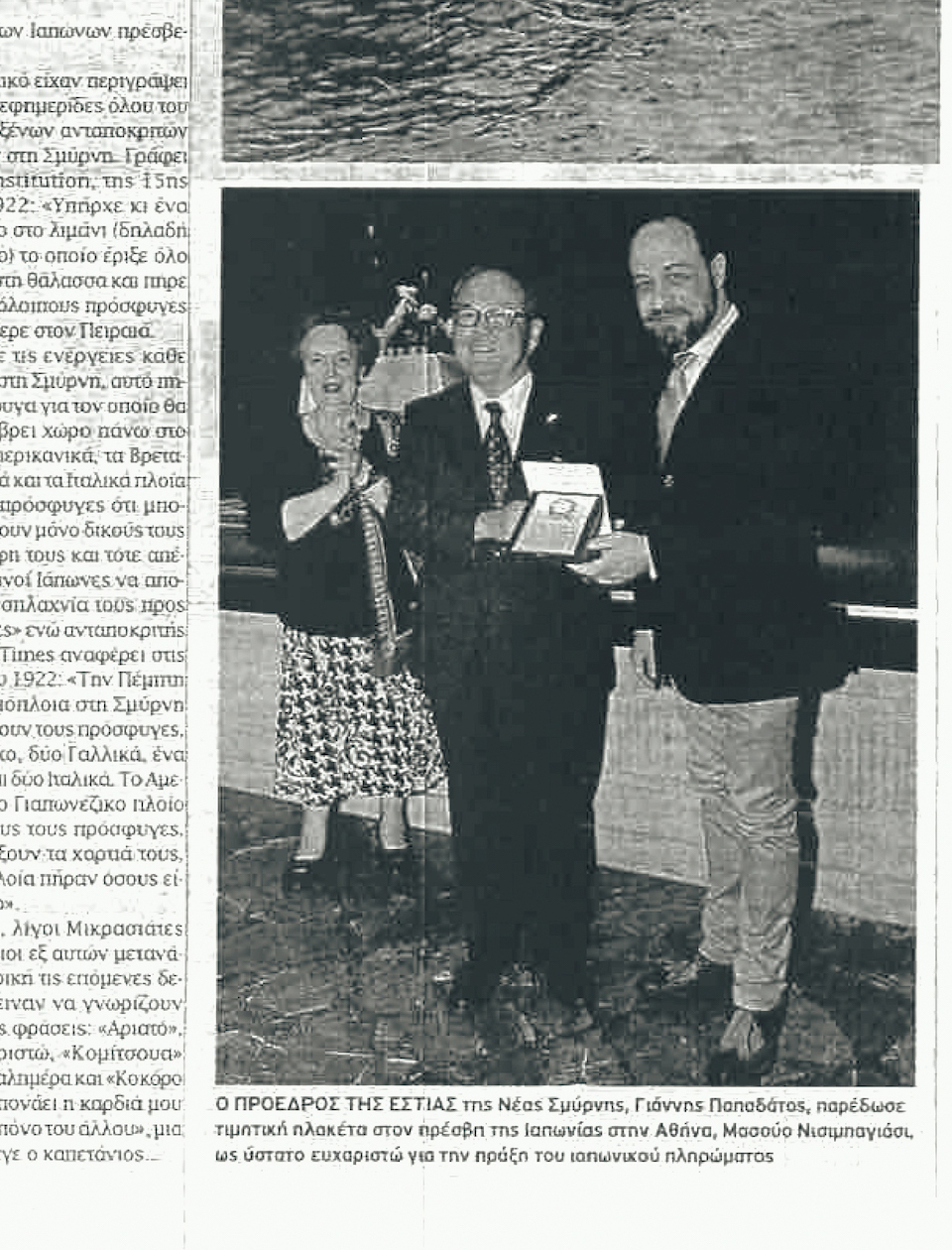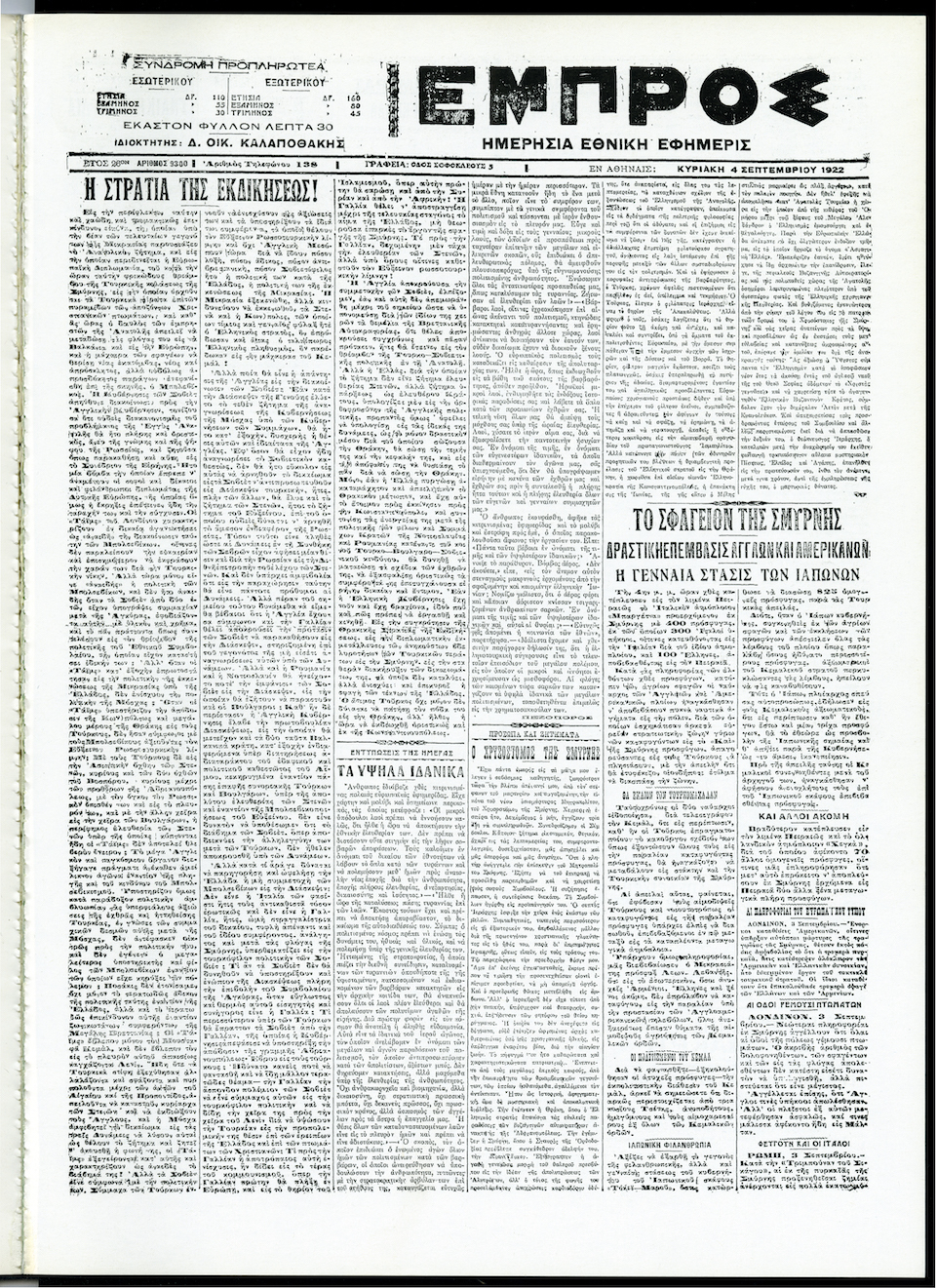Some Greeks have orally passed down the story of the rescue of many Greek refugees by a Japanese ship during the Smyrna disaster of September 1922. Nanako Murata Sawayanagi, professor at Toyo University has researched the matter and has this to say.


From the July 2016 issue of the Greek newspaper Ethnos. With the inscription of “Much Gratitude 94 Years On,” a plaque was given to the Japanese Ambassador to Greece at the time by descendants of the refugees to convey their appreciation for the rescue efforts by Japanese at Smyrna.

An article entitled “Massacre in Smyrna: Japanese Act Bravely” was printed in the Greek newspaper Empros on September 4, 1922 (September 17 in the Gregorian calendar), describing the efforts by a Japanese freighter to rescue Greek refugees.
Some say that no good deed goes unrewarded, but what happens if no one recognizes that good deed? Almost one hundred years have passed since a Japanese ship is said to have rescued scores of Greek refugees in Asia Minor. Normally, such a deed would be widely applauded, but the scantiness of the records mean that the event has been lost in the mists of history.
The stage for what happened lies in post-WWI Smyrna (now Izmir, Turkey), an Aegean port city in western Asia Minor, with roots harking back to Ancient Greece. After the war, the Ottoman Empire was partitioned, with Greece and its allies rushing in to claim territory. Turkey eventually gained its independence in October 1923, but at the high cost of forcing various long- established non-Turkish ethnic groups to abandon their homeland. That brings us back to the event.
On the night of September 13, 1922, five days after the Greek army had retreated, the Turks allegedly set fire to the residential district, which spread rapidly, forcing the inhabitants to swarm to the port to escape. Bertram Thesiger, a British-national captain of the George V at the time, recounts the scene as follows: “It was a terrifying thing to see even from the distance. There was the most awful scream one could ever imagine. ... Many did undoubtedly jump into the sea, from sheer panic. ... Mothers with their babies, the fire going on over their heads, and many of the bundles of clothes also on fire, and the people all screaming.”[1] Afterwards, the fire turned into a carnage, with the Greek population of the city at the time of 600,000[2] or more instantly transforming into refugees, many of whom are said to have lost their lives. This tragic incident is referred to as the “Asia Minor Disaster” in modern Greek history, as it drew the curtain on the 2,500-year history of Greek history in Anatolia.
At the time of the fire, some Allied warships were in the harbor, along with countless other merchant ships. But most of them refused to pick refugees up. Amidst all the chaos, a Japanese freighter was reported to have unloaded all its precious cargo to take on as many refugees as it could, transporting them onward to the Greek mainland.
According to a New York Times article of September 18, 1922, “There were six steamers at Smyrna to transport the refugees, one American, one Japanese, two French and two Italian. The American and Japanese steamers accepted all comers without examining their papers, while others took only foreign subjects with a passport.”[3] The American consul general in Smyrna verified that on the same day, telling the U.S. Secretary of State, “Passengers on the ship speak in the highest terms of the kindness of the Japanese officers and men.”[4] Later articles in The Atlanta Constitution[5] and The Boston Globe[6] echoed those statements.
The Greek newspaper Empros reported the incident with the headline, “Massacre in Smyrna: Japanese Act Bravely,” saying that “The brave actions by the captain of the Tokei-maru are worthy of note. Despite being threatened by the Turks, he succeeded in rescuing 825 of our Greek comrades. After he unloaded all the small boats aboard, the Kemali soldiers surrounded them, threatening to sink them. In response, the captain told them, ‘If you dare touch a hair on the head of any of the refugees, I shall regard it as an affront to the Japanese flag and a threat to the Japanese government.’”[7]
The fact that reputable media and diplomatic sources mentioned it several times leads to its plausibility. Perhaps because it happened amidst the chaos of war, there are inconsistencies among the reports about the dates and the number of ships, making it impossible to take any one particular account of the rescue by the Japanese as a “historical fact.”
I believe that when it comes to saving human lives, nationality ought to make no difference. However, when placed in certain historical situations, it is hard to stick to one’s beliefs. It is precisely because of the courageous reality of someone having done so, however, that I feel this action is still being talked about today. During my continued research on this topic, I have received many grassroots reports from people whose relatives had been rescued. Soon a century will have passed since the tragedy at Smyrna. Before that milestone is reached, I would like to see this good deed inscribed in history.

Nanako Murata Sawayanagi
After graduating from the Faculty of Letters at the University of Tokyo, Sawayanagi received a Ph.D. in history from New York University (NYU). Specializing in modern Greek history and the history and culture of the eastern Mediterranean, she now is a professor in the Faculty of Letters at Toyo University.
[1] Michael Llewellyn Smith, Ionian Vision: Greece in Asia Minor 1919-1922 (Ann Arbor: The University of Michigan Press, 2000), 309-310. [2] According to Greek Patriarchate Statistics in 1912, there were 1,782,582 Greeks in Asia Minor. Among the provinces in Asia Minor, Smyrna had the largest Greek population. i.e. 622,810. Dimitri Pentzopoulos, The Balkan Exchange of Minorities and Its Impact on Greece (London: Hurst & Company, 2002). 30. TABLE III 15. [3] “Smyrna’s Ravagers Fired on Americans,” The New York Times, September 18, 1922. [4] Documentary Evidence (767.68/450) cited from “Stavros Stavridis Special to The National Herald.” [5] The Atlanta Constitution, October 15, 1922, A9, cited from “Stavros Stavridis Special to The National Herald.” [6] The Boston Globe, December 3, 1922, E4, cited from “Stavros Stavridis Special to The National Herald.” [7] “Massacre in Smyrna,” Empros, September 4, 1922.





























